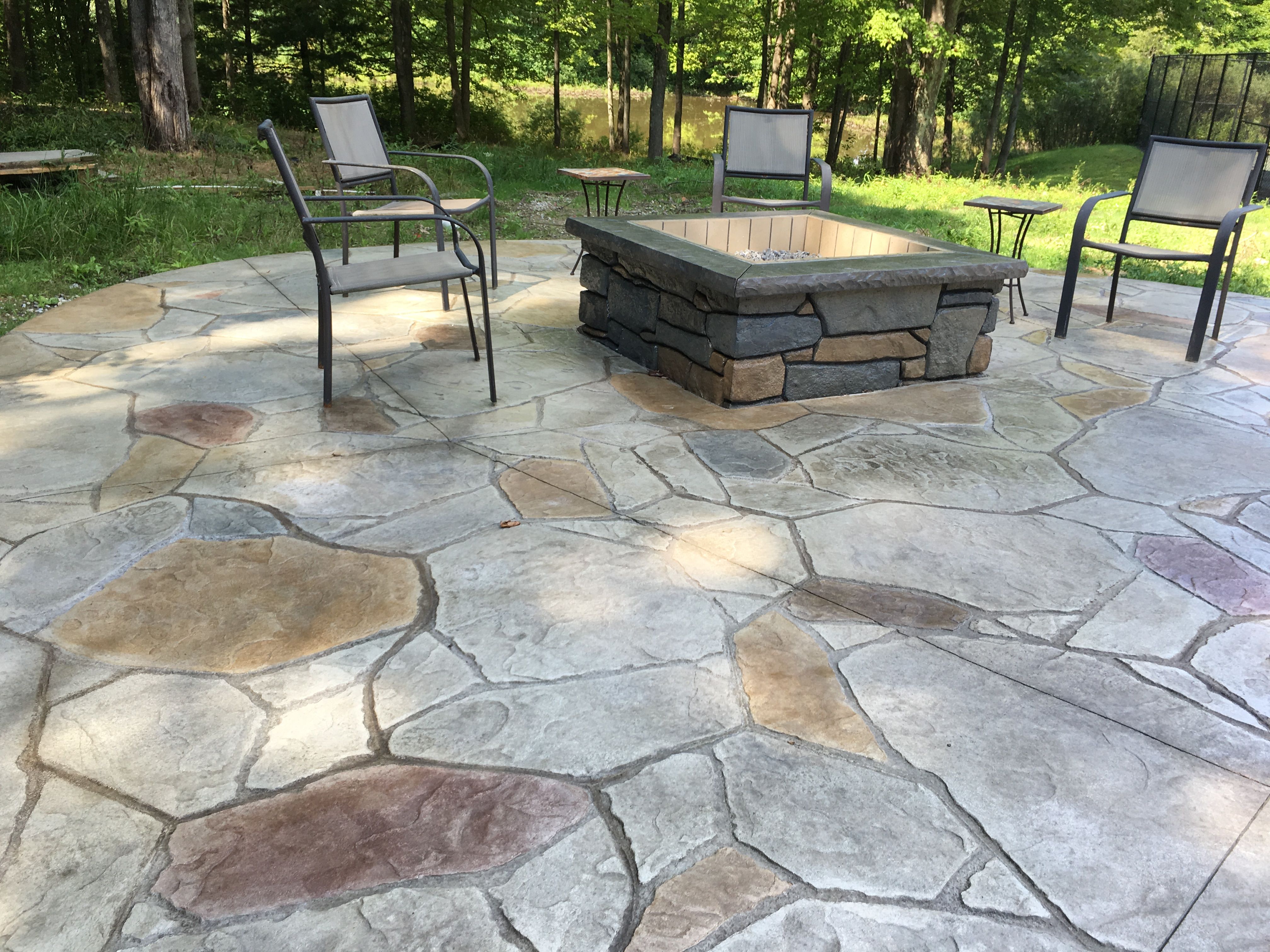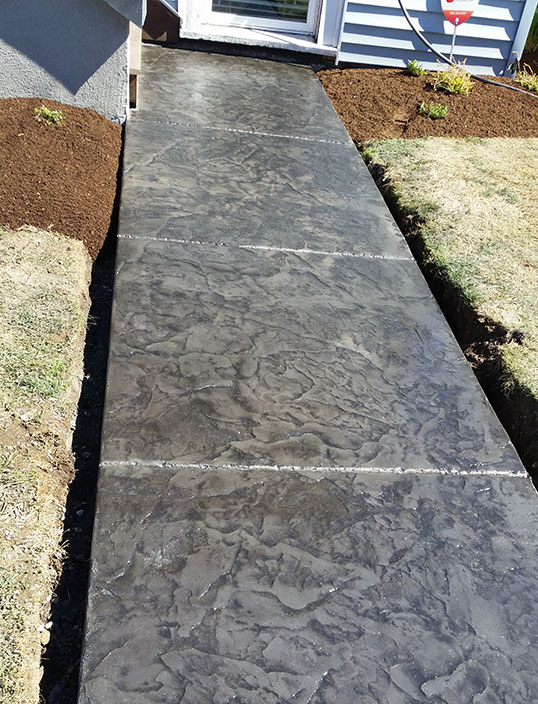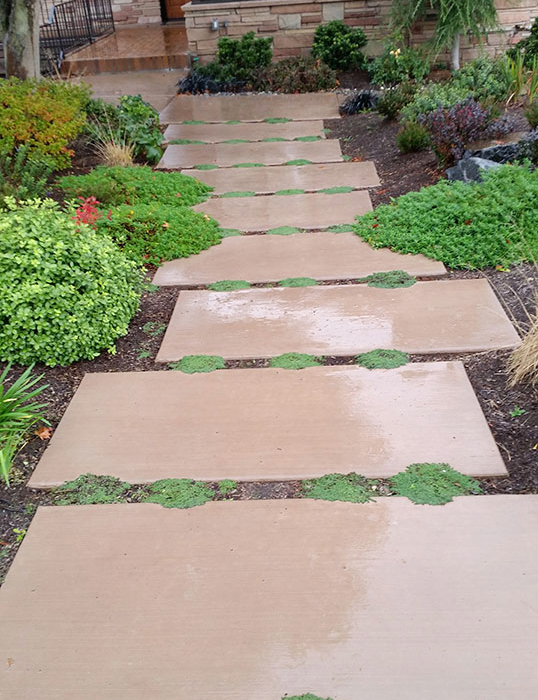What is stamped concrete?

by Alonso Romero
CA State Lic. Concrete & Masonry C-8
CA State Lic. General Contruction - B
Buckaroo Banzai the Concrete Nerd
Actual person performing the job
Date: 06/14/2020

Thinking about stone pavers, tile, brick, or wood to the exterior of your house, but not sure you can afford it? Stamped concrete is the solution you’ve been looking for.
For a beautiful, one-of-a-kind look, stamped concrete is hard to beat. Pattern and color options are almost unlimited. Stamped concrete copies the look of stones, such as slate and flagstone, tile, brick or even wood. With the wide variety of patterns and color choices, it is an excellent choice for sprucing up your patio, pool decks, driveways, and any outdoor space. It also costs less and requires less maintenance than other materials, making it a popular choice to bring a high-end look to your home, enhancing your outdoor spaces and adding value to your home.
Is stamped concrete right for my Los Angeles home?
Thinking about installing stamped concrete? Consider the following:
Pros:
- It’s durable and long-lasting.
- It’s more affordable than natural stone, brick or pavers, or wood.
- Offers nearly endless pattern and color choices.
- Easy to maintain when sealed
- Enhances outdoor spaces and adds to your home value
- Slip resistant when treated with a non-skid additive
Cons:
- Needs periodic cleaning and resealing
- Repairs can be difficult
- Not very DIY friendly
- Can develop minor cracks
Does it look real?
Stamped concrete can look incredibly realistic. Most stamping mats are molded from the actual materials they are designed to copy. Concrete contractors use a variety of methods to achieve natural-looking color variations to mimic what you would see in real stone or wood. If anything, stamped concrete is even better than the real thing because you won’t get weeds or moss growing in between the joints. In addition, stamped concrete won't rot or splinter like real wood.
How does it compare to stone or other materials?
When you compare it to similar options, stamped concrete beats out stone, tile and wood for many reasons.
- Maintenance: Stamped concrete can last for decades with minimal maintenance. Regular maintenance of cleaning and resealing stamped concrete should be done every 2 to 3 years on average. Other surfaces, such as pavers or natural stone, need ongoing maintenance to keep weeds out and to keep the joints filled with sand.
- Customization: The pattern and color choices offer complete customization that other surfaces just can’t offer.
- Price: Stamped concrete usually costs considerably less than installing natural stone surfaces or wood. While some lower-end paver options may have a lower installation price than stamped concrete, they may end up costing more for maintenance, repair or replacement.
- Installation: Pouring stamped concrete is faster than setting natural stone or pavers.
Is it slippery?
Stamped concrete is a textured surface, making it often more slip resistant than conventional slab concrete. However, just like natural stone, it can become slippery when wet. That’s why you want to make sure you use a heavier texture or add non-skid additives to your stamped concrete in high traffic areas, such as an entryway or pool deck. Talk to your contractor to find out what solutions are out there for a slippery concrete walkway.
How do I maintain my stamped concrete?
Stamped concrete is one of the most durable and long-lasting paving materials available and requires less maintenance than stone, brick or wood. Stamped concrete should be cleaned and resealed every two to three years on average. How frequently you have to do this depends on how much the area is used, with car and foot traffic, chemicals or the weather. Before you reseal stamped concrete, you just need to clean it with a garden hose or pressure water, some mild detergent and a push broom. Color hardeners and sealers make the surface stronger, making it more resistant to abrasion and helps to block the penetration of water, stains, dirt and chemicals. While it is relatively easy to clean and maintain stamped concrete, it’s always a good idea to remove oil, grease or other spills immediately.
How easy is it to repair stamped concrete?
When installed correctly, stamped concrete is highly resistant to cracking. Even if it does experience minor cracks, the cracks often blend in with the pattern and joint lines, making it hard to find.
Weather, dirt, and traffic can take their toll on the color of your stamped concrete. Periodically cleaning and resealing the concrete can minimize any color change. Even if the color has faded due to years or neglect, it can often be restored to its original state by cleaning and resealing.
How long with stamped concrete last?
Just like conventional concrete, stamped concrete surfaces will last for decades when properly installed and maintained, even when exposed to harsh traffic and weather conditions. Stamped concrete can be even more durable than standard concrete, especially if a color hardener is used when it’s poured. If you apply a sealer, it will further protect your stamped concrete from wear and tear and make it easier to maintain.
How is stamped concrete installed?
There are many steps necessary that must be done carefully and quickly to achieve uniform results across the entire slab before the concrete sets. Therefore, the patter must be carefully pre-planned and diagrammed, with tools and labor ready to go.
First, the concrete is poured and allowed to set to the proper consistency before color hardeners and release agents are added. Then the concrete is tested again before applying the stamp patterns. Finishing work, such as detailing and cutting contraction joints, completes the projects.
While most stamping is done on nearly poured concrete, existing concrete that’s in good condition can be covered with a stamped concrete overlay.
Can I do it myself?
Because of all the elements that must be done quickly, we don’t recommend installing stamped concrete yourself. You only have one chance to get it right. You can’t finish it later if you run out of time. You can’t take it apart and re-do it. For all these reasons and more, we suggest this is a project you leave to the pros. So, call the pros at Concrete Decor Contractor at 1-818-722-8124 for your consultation today!

